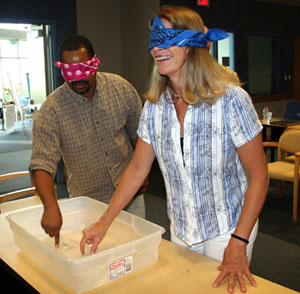Seagrasses provide a safe habitat to many small fish and crustaceans. If seagrass meadows are present, it is hard for predators to find their prey. However, on mudflats there is nowhere for these small animals to hide.
Objective
This activity will show students the role of seagrass in the protection of small fish.
Materials
- Construction paper (or plastic Easter grass, if available)
- About 80 Paperclips
- 4 Blindfolds
- 2 Plastic bins
Procedure
Rip the construction paper into long strips (construction paper represents seagrass). Place all of the ripped paper into one bin. Use half of the paperclips in the bins with the construction paper. Attach some of the paperclips to the construction paper and spread the rest on the bottom of the bin. Spread the other half of the paperclips in the bottom of the other bin. Pick 4 students to participate. Blindfold each student. Assign two of the students to one bin and the other two to the other bin. Each team will have 30 seconds to pick through their bin (students may only directly reach down and pick up paperclips, not rub their hands against the bottom). Once someone has picked up a paperclip, they may place it outside of the bin. After 30 seconds, count the number of paperclips that were picked out of each bin.
Discussion
After the activity is finished, ask students what the difference was between the two bins. Make the connection between the paper and the seagrass. The team with the seagrass in their bin should have captured fewer paperclips because the seagrass protects the “prey” from predators.
National Science Education Standards
9-12 A. Science as Inquiry
9-12 C. Life Science
- Interdependence of organisms; behavior of organisms
